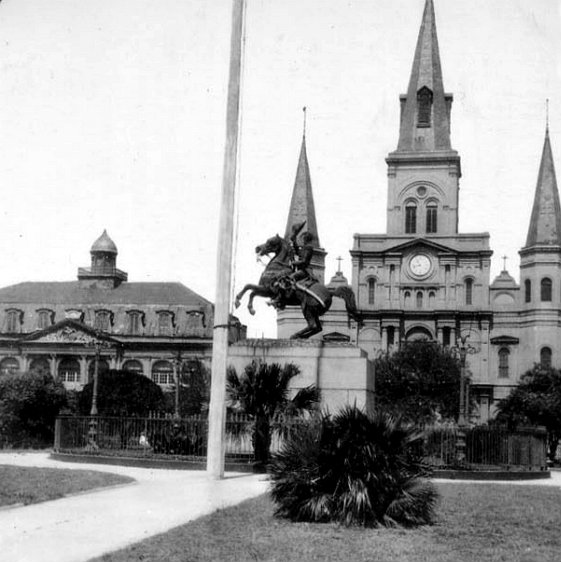| "Historic Old New Orleans" |

| The image above and the text below are from a postcard published in 1920. |
Ever since its founding in 1718 by Sieur de Bienville, New Orleans has been a place of
romance, contrasting dramatically with other American cities. Upon this little square have
taken place some of the most stirring events in American history.
First, it was the Place d' Armes, around which Bienville built his city, then followed the
many dramatic events in New Orleans' early history. Now it is called Jackson Square. The
statue is that of Andrew Jackson, the hero of the Battle of New Orleans.
In the background rise the triple spires of the Cathedral of St. Louis. Don Andres
Almonaster y Roxas, who gave it to the city, died 134 years ago, yet every Saturday at
twilight, services are still held here in his memory.
At the left of the Cathedral is the Cabildo, once used as administrative and legislative
headquarters, now a museum.
From a village of a few huts, New Orleans has expanded through the years to a great city.
Lying below the flood level of the Mississippi River, its existence depends upon the
stability of the levees which hold back the waters of the mighty river.
Yet, it is the Mississippi and its alluvial valley, richer than that of the Nile, which pours into
the lap of New Orleans the wealth of the South and the West - until the levee, the wharves
and the contiguous streets are gorged with the raw staples: sugar, molasses, rice, tobacco,
corn, pork, staves, wheat, oats, flour and, above all else, from one-third of the country's
entire supply of cotton.
romance, contrasting dramatically with other American cities. Upon this little square have
taken place some of the most stirring events in American history.
First, it was the Place d' Armes, around which Bienville built his city, then followed the
many dramatic events in New Orleans' early history. Now it is called Jackson Square. The
statue is that of Andrew Jackson, the hero of the Battle of New Orleans.
In the background rise the triple spires of the Cathedral of St. Louis. Don Andres
Almonaster y Roxas, who gave it to the city, died 134 years ago, yet every Saturday at
twilight, services are still held here in his memory.
At the left of the Cathedral is the Cabildo, once used as administrative and legislative
headquarters, now a museum.
From a village of a few huts, New Orleans has expanded through the years to a great city.
Lying below the flood level of the Mississippi River, its existence depends upon the
stability of the levees which hold back the waters of the mighty river.
Yet, it is the Mississippi and its alluvial valley, richer than that of the Nile, which pours into
the lap of New Orleans the wealth of the South and the West - until the levee, the wharves
and the contiguous streets are gorged with the raw staples: sugar, molasses, rice, tobacco,
corn, pork, staves, wheat, oats, flour and, above all else, from one-third of the country's
entire supply of cotton.
| The link to this page is: http://old-new-orleans.com/NO_Historic_New_Orleans.html Back to Old New Orleans Whispers - Home |